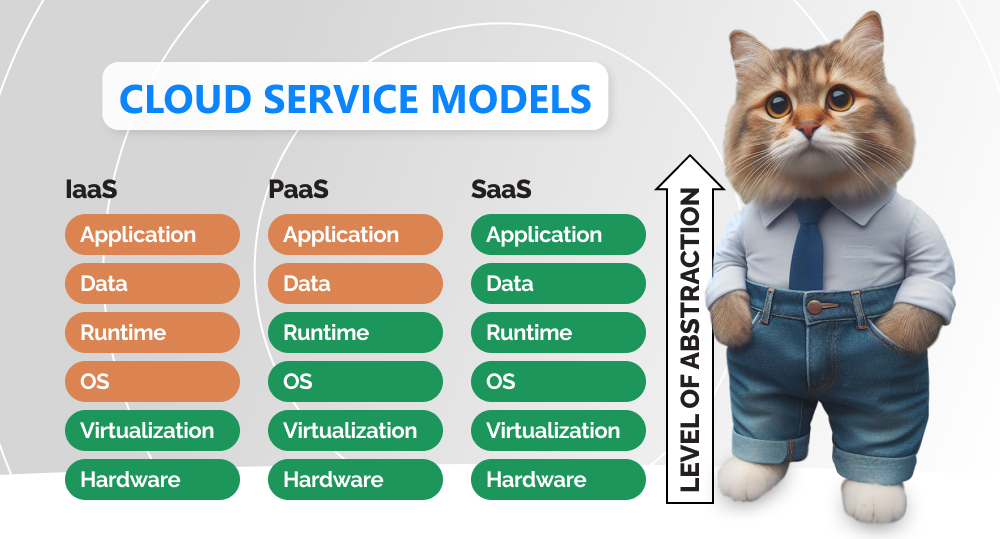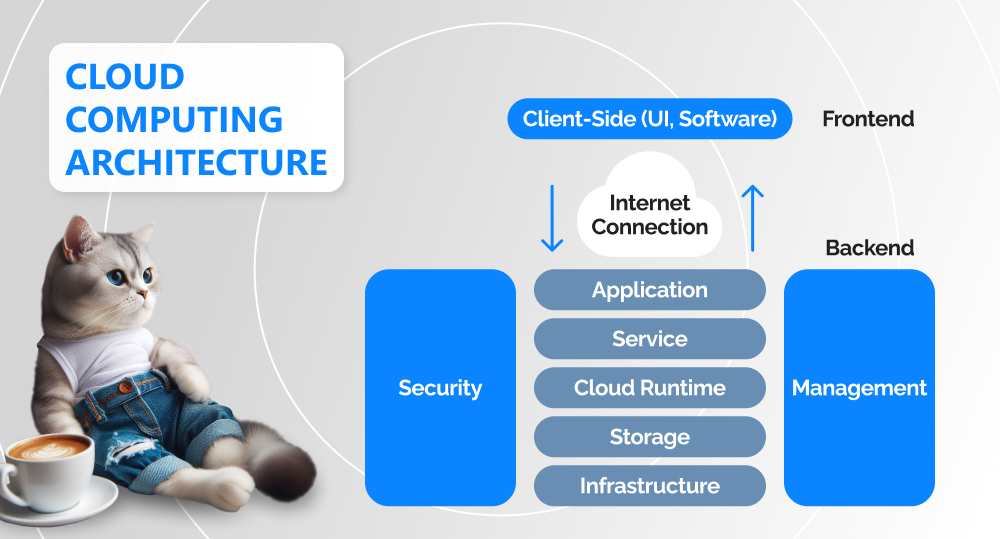A SaaS framework is part and parcel of cloud applications, as it predetermines their scalability potential, integration options, and architectural patterns, as well as lays the groundwork for the entire development process. On this account, do not just take wild guesses, when selecting it for your SaaS project. Lack expertise to make a deliberate strategic decision?
In this article, we will clue you in on the key cloud-related concepts and shed light on the pros and cons of the top SaaS development frameworks. Let's get started!
written by:
Maxim Butov
Software Architect
A SaaS framework is part and parcel of cloud applications, as it predetermines their scalability potential, integration options, and architectural patterns, as well as lays the groundwork for the entire development process. On this account, do not just take wild guesses, when selecting it for your SaaS project. Lack expertise to make a deliberate strategic decision?
Contents
Welcome to the SaaS World!
Before we dive into the tech nature of the cloud environment, let's linger for a moment and cast a glance at the following table.
Field
Solution
Finance & Insurance
Avalara, Stripe, Guidewire
Healthcare
ZocDoc, HealthJoy
Customer Relationship Management
Salesforce, Hubspot, Zendesk
Content Management
WordPress, Sitecore
Entertainment
Netflix, Spotify
Logistics
EasyShip, Flexport
eLearning
DuoLingo, EdApp
eCommerce
Shopify, Wix, BigCommerce
Workflow Management
Asana, Jira, Trello, Google Workspace
How many familiar names can you spot there? We bet you use at least three of these (or similar) SaaS apps daily. And you are not the only one who reposes great trust in them. This is also proved by statistics, indicating that cloud products keep winning the hearts and minds of wide user groups, making the global SaaS market grow at an annual rate of 13.7%.
But what is hiding behind this quaint abbreviation? SaaS, or Software-as-a-Service, is a term that embraces digital solutions managed in a cloud environment by a third party and delivered to users over the internet on a subscription basis. The history of SaaS hearkens back to the 1960s, but its real heyday started in the late 1990s, with Salesforce introducing its first cloud-based CRM system.
On-Premises vs. Cloud
If we compare SaaS to on-premises solutions, we will see why this ingenious contrivance caught on:
- First, with SaaS, it becomes possible to switch to off-premises servers managed by a service provider;
- Secondly, since there is no need to install software on the client's infrastructure and update it, users can avoid huge licensing and maintenance costs;
- Thirdly, it offers highly flexible pricing models that allow enterprises to take as many resources as needed at the moment, eliminating downtime and overpayment;
- And last but not least: with SaaS, you can spread out the global load geographically and speed up your app.
But do not get us wrong, SaaS is not a silver bullet. It is just one of the options with its peculiarities to keep in mind. For instance, to unleash SaaS flexibility to the fullest, it is crucial to set up autoscaling. The reverse side here is the heavy cost of in-house specialists capable of overcoming the challenge (i.e., sometimes, it is way cheaper to employ and manage on-premises software).
Besides, cloud solutions have limited customization potential (you can't change the offered infrastructure) and can bring in certain access issues (if the backup is not set up) and security risks (the survey by BlueVoyant suggests that 93% of SaaS adopters face them).
Cloud Service Models
When expounding SaaS, we can't but mention its counterparts: Infrastructure-as-a-Service (IaaS) and Platform-as-a-Service (PaaS). Here are the key distinctions of these models: IaaS comes in handy when you need resources like virtual machines or servers, PaaS lets users take advantage of infrastructure and middleware, and SaaS provides fully-fledged digital products easily tailored to your current goals.
SaaS Architecture: Brief Overview
If you plan to follow the lead of renowned SaaS giants and hit the digital world with a stunning cloud app, you should gain at least a rough idea of how such solutions work under the hood.
Traditional SaaS web development architecture consists of the following layers:
- a frontend,
- a backend, and
- an internet-based delivery system.
The frontend is the part users interact with. This side of the app involves a software component and a graphical UI. The application component, storage, service, infrastructure (CPU, GPU, etc.), and cloud runtime belong to the backend. While a cloud vendor ensures its security and management, your task is to create the client-side layer and keep it compatible with the backend.
This serverless architecture can be built with a programming language like PHP, Java, .NET, Node.js, or Python.
Depending on the number of users who may access the cloud infrastructure, there can be:
- Public or multi-tenant environments (a cheaper option, presupposing that servers, virtual machines, and other resources are shared between several users);
- Private or single-tenant environments (a secure model that provides a private network and infrastructure to each client);
- Hybrid or mixed-tenant environments (combine on-premises infrastructure and a public cloud).
One more notion that is closely related to cloud deployment models is a multicloud — an approach when a user simultaneously employs the infrastructure of several cloud providers. By the way, 920 out of 1000 tech organizations say this strategy perfectly works for their businesses.
9 Best SaaS Development Frameworks
Another concept to explore is a SaaS product development framework. In a nutshell, this is a selection of technologies and tools required to build robust SaaS products. Since it exerts a major influence on system capabilities and limitations, you should choose it with an eye to long-term usage.
Below, you will find the expert overview of the most popular SaaS development frameworks.
#1. .NET SaaS Framework
Created in 2002 by Microsoft, this SaaS application development framework remains one of the top choices for cloud-based solutions. It ensures performance, security, and productivity and possesses the following characteristics:
- Strict language compilers and a garbage collector employed for automatic memory management make the framework memory- and type-safe;
- It supports the following languages: C#, Visual Basic, F#;
- Its cross-platform, object-oriented nature enables developers to create large-scale web applications for Windows, Linux, and macOS;
- At the same time, it can be rather challenging to keep pace with frequent updates of the framework's tools and libraries, especially for beginners.
#2. Laravel SaaS Framework
Laravel is an open-source, free, PHP-based framework that allows developers to build web applications with the model-view-controller (MVC) architecture pattern at the core. Here is what you should know about the framework:
- It can boast elegant syntax and pre-installed authorization libraries;
- By enabling cross-platform development, Laravel makes your solution available on web browsers, mobile devices, and desktops;
- This is a highly secure framework, as it separates tenants' data and employs a Bcrypt hashing algorithm (i.e., doesn't save passwords in databases);
- It ensures seamless integration via APIs;
- However, since it is a lightweight framework, it is not a good choice for large-scale applications.
#3. Symfony
Take a look at another PHP SaaS framework renowned for high performance, robust architecture, and agility. The features that distinguish it among the other top SaaS frameworks are:
- Well-structured documentation;
- Accelerated web app development;
- Component reusability.
Still, many developers find Symfony more recondite to get started with in comparison to Laravel.
#4. Django SaaS Framework
Unlike Laravel or Symphony, Django is a free framework based on Python and employed for open-source SaaS projects. Many developers consider it the best framework for SaaS applications, and here is why:
- It contains different packages ready to be imported into a codebase, which shifts the burden of code creation for authentication, session management, and other processes from you;
- It is highly scalable and allows for server separation and load balancing;
- This Python SaaS framework offers multiple built-in tools, as well as an admin interface.
On the other hand, it follows the URL RegEx pattern that can pose certain challenges for junior specialists.
#5. Next.js SaaS Framework
Next.js is the most suitable SaaS development framework for those who plan to build a single-page application (SPA) with strong SEO potential. These are its major peculiarities:
- Automatic code splitting;
- Server-side rendering (SSR) that empowers developers to boost page load time;
- Embedded API routes, simplifying the communication between a frontend and a backend.
But keep in mind that Next.js is not the best SaaS framework to use for simple solutions that do not involve static site generation or SSR, as it may bring in extra complexity and overheads.
#6. Vue.js SaaS Framework
Vue can be your go-to option, in case you are searching for a SaaS customer onboarding framework (and not only), as it targets UI development. Let's go into the specifics of Vue.js:
- At its core, it has such languages as CSS, JavaScript, and HTML;
- Its syntax is characterized by declarative rendering;
- It is rather simple and easy to learn;
- It allows engineers to track data updates employing two-way data binding;
- However, since this popular framework was developed in China, certain language issues may arise, when scrutinizing its manuals or plugin descriptions.
#7. Sails.js SaaS Framework
Another SaaS development framework to consider is Sails.js. It is an excellent option for Node.js web applications. Check its brief description:
- It serves the needs of JavaScript solutions;
- Thanks to object-relational mapping (ORM), it supports any database type;
- This Node.js SaaS framework ensures role-based access control.
#8. Ruby-on-Rails SaaS Framework
This full-stack SaaS development framework went out into the world in 2004. By providing helpful tools and HTML templating solutions, it still assists engineers in creating industry-leading products. Let's shortlist its hallmarks:
- A great choice for beginners;
- Enhanced code readability;
- Updating databases;
- Solid security protection.
However, on the other side of the scale, we have runtime speed issues and restrained flexibility.
#9. Angular SaaS Framework
Angular is another SaaS development framework. It is based on TypeScript and widely employed for front-end elaboration. It involves components that are responsible for different screen elements (views). Special services integrated into its components ensure background functionality.
Here are a few more facts about this SaaS governance framework:
- It has an MVC architecture;
- With Angular, you can build dynamic client-side apps;
- TypeScript conduces to a more accurate coding process and great scalability;
- On the downside, it can't boast extensive SEO capabilities.
One More Tip
Congrats, guys! You've finally got one step closer to your SaaS project. Now, that you are well aware of all the intricacies of cloud solutions and frameworks, it is time to think about a SaaS development team.
Sure, you may hire in-house developers from scratch, but we have a different take to recommend. If you don't want to spend months looking for proficient specialists and wasting your money, try outsourcing. In doing so, you will get a well-knit team and jumpstart a project without delays and overpayment. Don't know where to start? Just check this step-by-step guide.
Have a game-changing SaaS app idea on your mind and can't wait to bring it to fruition? Share it with our experts, and they will show you the most efficient and budget-friendly implementation route.
Valuable Insights
SaaS stands for Software-as-a-Service and refers to a subscription-based way of accessing software solutions located and managed in a cloud.
When users take advantage of software over the internet at a certain fee, and a service provider takes charge of its maintenance and support, we are witnessing a Software-as-a-Service model in action. In this scenario, users can pay only for the resources they need at the moment, eliminating the necessity of installing software on their computers.
Breakthrough SaaS solutions can be traced in various business domains: from customer relationship management and entertainment and media services to finance and logistics. The most illustrious SaaS application examples are Netflix, Zoom, Shopify, Slack, Canva, Google Workspace, Avalara, and others.
A SaaS development framework is a ready-made suite of technologies and tools (back-end and front-end frameworks, databases, APIs, etc.) required to build a cloud-based application. SaaS frameworks are an indispensable part of the software development process.
A SaaS journey framework encompasses the following stages: ideation, business analysis, SaaS architecture and design elaboration, app creation, testing, and launching. When building SaaS products, you should also select a cloud provider and a software delivery and pricing model.
At the onset of a SaaS project path, you should get a clear vision of a product idea, test its feasibility, do the calculations, and find a proper amount of resources. Then, it is essential to define whether your development team will be in-house or outsourced. After hiring all the required specialists under the predefined model and making all the financial and administrative decisions, you may get down to the SaaS development process.
Customized SaaS web and mobile apps are rather flexible in terms of features and functions you can embed into them. Therefore, their exact cost depends on the implementation stage (whether it is from-scratch development or enhancement of the existing SaaS platform), integration capabilities, data security mechanisms, feature complexity, and the development team's expertise. On average, such projects require $20–300k of investments.
On-premises software is the one that is installed on local computers and servers. Normally, you have to pay licensing fees to download it, while its further management and upgrading fall within your area of responsibility.
If you access the software via the internet without installing it, you deal with a cloud-based solution. In this model, it is a service provider who keeps a sharp eye on software state and relevance and lets you enjoy the product on a subscription basis or even for free.
To better remember the difference, bear in mind the following examples: Microsoft Word (on-premises) and Google Docs (cloud-based).
When offering SaaS-based solutions, service providers can let users select an architecture pattern (single-tenant or multi-tenant) in compliance with their requirements and budget. The first option presupposes that a client will have access to a dedicated server and supporting infrastructure. This approach is more secure, yet pricey. In a multi-tenant environment, several users share the same server, virtual machine, and other resources. This option is more risky but offers cost-efficiency.
Simply put, the common architecture of a SaaS solution contains three major elements:
- Front-end layer (easy-to-navigate and highly scalable user interfaces built with frameworks like CSS, HTML, or JavaScript);
- Back-end layer (infrastructure, application, service, storage, and cloud runtime);
- Delivery component (ensures the communication between a backend and a frontend).
Java is a multiplatform, class-based programming language developed by Oracle. Hibernate, Spring, Grails, and Apache Wicket are the frameworks built with Java.
Golang, a.k.a. Go, is a statically typed, open-source language characterized by simple syntax, independent error handling, and portability. Gin, Fiber, and Echo are Golang-based frameworks.

Contacts
Feel free to get in touch with us! Use this contact form for an ASAP response.
Call us at +44 151 528 8015
E-mail us at request@qulix.com









